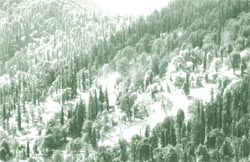Barren continent
 some 250 million years ago, Europe was devastated by the great Permian extinctions which wiped out 95 per cent of the extensive conifer forests covering the land. The impact of this was more widespread than the extinction of the dinosaurs and other forms of life by the asteroid impact 60 million years ago. While it took plants 10,000 to 100,000 years to recover from the dinosaur disaster, what is puzzling scientists is the 5 million years that it took the trees to make a comeback to the European mainland. "The amazing thing is that it took so long," says Henk Visscher of Utrecht University.
some 250 million years ago, Europe was devastated by the great Permian extinctions which wiped out 95 per cent of the extensive conifer forests covering the land. The impact of this was more widespread than the extinction of the dinosaurs and other forms of life by the asteroid impact 60 million years ago. While it took plants 10,000 to 100,000 years to recover from the dinosaur disaster, what is puzzling scientists is the 5 million years that it took the trees to make a comeback to the European mainland. "The amazing thing is that it took so long," says Henk Visscher of Utrecht University.
The cause of the Permian extinctions remains a mystery, although something destabilised the ecosystem over tens or hundreds of thousands of years ago, says Visscher. Lava spewing from volcanoes covered a large part of Siberia and could have been the cause of the extermination of certain species. This was accompanied by some other changes like a drop in sea level and rise in temperatures, most probably due to the green house effect.
The post-extinction period has not been studied much because of the scarcity of fossils. However, researchers have been able to collect and study fossils of pollen and spores found across Europe, North Africa and Israel.
They found fungal spores at the peak of the extinction, marking the decay of vast amounts of plant material. For millions of years the flora largely comprised lycopods of the club moss family. These can grow to two metres in height and have leaves along a single stem with a cluster of spores on top.
As spore-bearing plants, lycopods usually need moist environments to reproduce, which proves that they existed along rivers and streams, says David Dilcher, a palaeobotanist at the University of Florida in Gainesville, who worked with Visscher. Members of this species are still found in the wetlands.
The new species of conifers which reappeared in Europe came from distant lands. The warm, dry forest took half a million years to recovery fully. Compare this with the few thousand years taken by the northern forest after the last ice age.
Conifer forests in Australia and Antarctica were unaffected by the extinctions because they were in the cool southern latitudes, says Greg Retallack of the University of Oregon in Eugene. But most plants suffered badly. "The surprising thing is how long life seemed to struggle after this," says Retallack. He suggests plants may have "had to struggle against some noxious pollutant" such as sulphurous volcanic gases.
